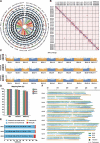Telomere-to-telomere haplotype-resolved reference genome reveals subgenome divergence and disease resistance in triploid Cavendish banana
- PMID: 37701454
- PMCID: PMC10493638
- DOI: 10.1093/hr/uhad153
Telomere-to-telomere haplotype-resolved reference genome reveals subgenome divergence and disease resistance in triploid Cavendish banana
Abstract
Banana is one of the most important crops of the world. Cavendish-type bananas, which have a monospecific Musa acuminata origin (AAA), account for around half of the global banana production, thereby are of great significance for human societies. However, until now, the high-quality haplotype-resolved reference genome was still undecoded for banana cultivars. Here, we reported the telomere-to-telomere (T2T) and haplotype-resolved reference genome of 'Baxijiao' (Cavendish) consisting of three haploid assemblies. The sizes of the three haploid assemblies were estimated to be 477.16 Mb, 477.18 Mb, and 469.57 Mb, respectively. Although with monospecific origins, the three haploid assemblies showed great differences with low levels of sequence collinearity. Several large reciprocal translocations were identified among chromosomes 1, 4, and 7. An expansion of gene families that might affect fruit quality and aroma was detected, such as those belonging to sucrose/disaccharide/oligosaccharide catabolic processes, sucrose metabolic process, starch metabolic process, and aromatic compound biosynthetic process. Besides, an expansion of gene families related to anther and pollen development was observed, which could be associated with parthenocarpy and sterility of the Cavendish cultivar. Finally, much fewer resistance genes were identified in 'Baxijiao' than in M. acuminata, particularly in the gene clusters in chromosomes 3 and 10, providing potential targets to explore for molecular analysis of disease resistance in banana. This T2T haplotype-resolved reference genome will thus be a valuable genetic resource for biological studies, molecular breeding, and genetic improvement of banana.
© The Author(s) 2023. Published by Oxford University Press on behalf of Nanjing Agricultural University.
Conflict of interest statement
The authors report no conflict of interest.
Figures




References
-
- FAO . World Food and Agriculture-Statistical Yearbook 2020. (FAO, 2020)
-
- D'Hont A, Denoeud F, Aury JMet al. . The banana (Musa acuminata) genome and the evolution of monocotyledonous plants. Nature. 2012;488:213–7 - PubMed
LinkOut - more resources
Full Text Sources
Miscellaneous

